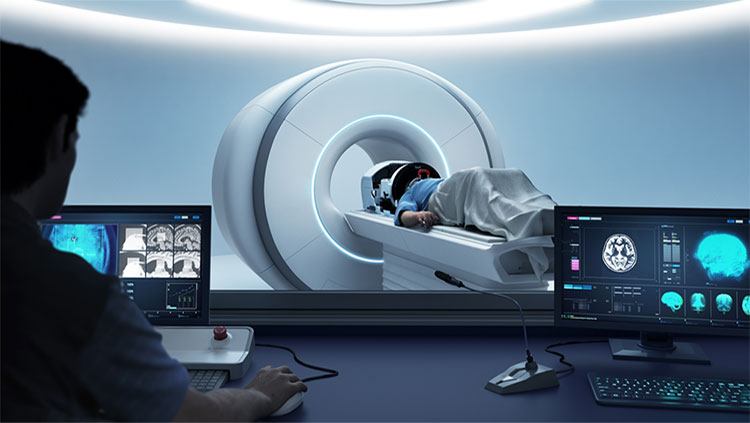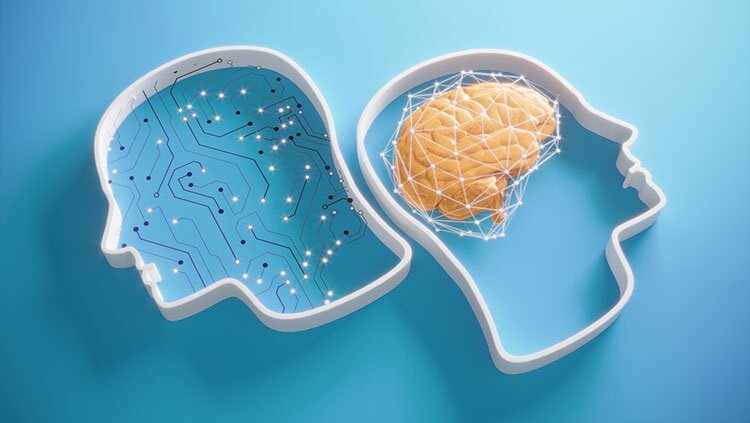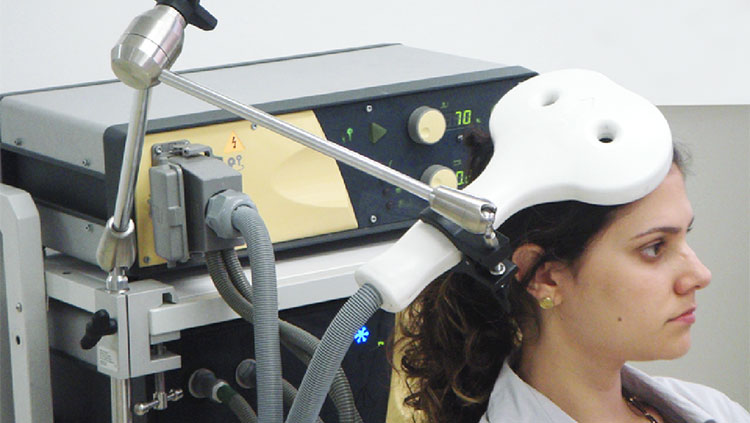How Neuroscience Is Treating Neurological Disease With Sound Waves
- Published29 Sep 2020
- Author Katherine Still
- Source BrainFacts/SfN

Rick used to have trouble steadying his hands to pour his coffee in the morning. For years, he dealt with the excessive and ever-worsening shaking caused by essential tremor. The disorder isn’t life threatening, but patients like Rick say the shaking often makes them feel inadequate.
“I would like to be able to help my wife put on a necklace,” he said, in an interview with the Focused Ultrasound Foundation, when his tremor was at its worst.
But in 2016, Rick’s life changed when he received a treatment that treats brain tissue with sound waves. Immediately following the non-invasive procedure, lying in his hospital bed, Rick was able to hold out his hand, flat and steady.
Howard Eisenberg, a neurosurgeon at the University of Maryland School of Medicine, employed high intensity focused ultrasound to treat Rick’s tremor. Eisenberg explains that the effect of the procedure is immediate and can be witnessed in real time. “We examine [the patient] many times throughout the [focused ultrasound] procedure,” Eisenberg says. “The effects we are looking for, like a tremor, would go away immediately, it happens instantaneously if you’re in the right spot.”
Using sound waves to treat disease has helped many patients like Rick in recent years. The average patient in clinical trials experiences an approximate 50% improvement in tremor severity, which can mean newfound independence in completing daily motor tasks like buttoning a shirt.
On Target
In the case of essential tremor patients, physicians target the thalamus because it is the central hub for motor circuits and thought to be overactive in patients with essential tremor. The patient’s head is shaved and placed in a stereotactic frame, a device that serves as a spatial reference, so physicians can use exact coordinates to locate the problematic brain region. Patients wear the head frame within a magnetic resonance imaging (MRI) scanner, to visualize the target brain region throughout the procedure. Then, sound waves — energy/vibrations which travel through the air in the form of waves, are directed toward the target brain tissue.
To precisely focus the sound energy, an acoustic lens, a device that bends sound waves, causing them to converge, precisely focuses the sound energy. Doctors have likened this technique to using a magnifying glass to focus light into a pinpoint. Once sound waves are directed toward brain tissue with enough energy, the energy is converted to heat within the tissue and dissolves problematic brain tissue.
In Real Time
Focused ultrasound target areas are kept as small as possible, using MRI to monitor any off-target effects of the ultrasound. Sound enters the skull from many angles, limiting heat transfer at any particular point in the skull itself. “We take advantage of the MRI as a very precise thermometer…to ensure that we’re not causing damage to any of the surrounding [brain] structures,” says Jeff Elias, a neurosurgeon at the University of Virginia and pioneer in treating tremor patients with focused ultrasound.
If there is damage from the procedure, it can be detected by MRI as heat or visualized as a new lesion within brain tissue. “You can see whether you have the tremor going away, but you’re not getting sensory numbness or anything like that,” explains Eisenberg, noting patient symptoms can be assessed in real-time since they’re awake during the procedure.
Generally, patients elect for focused ultrasound over surgery because it is non-invasive and carries fewer risks. “You don’t have to implant anything, so there’s really no risk of infection, and very low risk of hemorrhage,” Eisenberg says.
Still, side effects do occur in a minority of patients, likely caused from heating of small regions of brain tissue. Patients may experience issues with balance, gait, and weakness, but these effects are often temporary.
The future of treating neurological disease
Because focused ultrasound is a new technique, Elias explains that “the long-term durability [for treating tremor] is still being evaluated.” Initial follow-ups have shown that patients have experienced continued relief for up to four years. It is currently unclear if patients will require additional focused ultrasound treatments throughout their life to control tremor, or other diseases.
There are still improvements to be made. For patients, Elias explains, undergoing the procedure without having their head shaved would be a major improvement. Additionally, “Clinicians would like to be able to focus ultrasound beams throughout the brain, right now [the machinery] just focuses really well in the central areas,” Elias says.
Clinical trials are currently underway to test focused ultrasound in treating neuropathic pain, depression, Alzheimer’s disease, epilepsy, Huntington’s disease, traumatic brain injury, dementia, brain metastases, and other neurological diseases.
“There will probably be a lot of interest and development in the years to come, I think [focused ultrasound] is a new tool for neuroscience,” Elias says. “Where it actually winds up nobody knows, but it’s definitely a tool that’s making its way experimentally into the labs and clinically into the hospitals.”
CONTENT PROVIDED BY
BrainFacts/SfN
References
Bond, A. E., Shah, B. B., Huss, D. S., Dallapiazza, R. F., Warren, A., Harrison, M. B., … Elias, W. J. (2017). Safety and Efficacy of Focused Ultrasound Thalamotomy for Patients With Medication-Refractory, Tremor-Dominant Parkinson Disease: A Randomized Clinical Trial. JAMA Neurology, 74(12), 1412–1418. PubMed (29084313). doi: 10.1001/jamaneurol.2017.3098
Elias, W. J., Lipsman, N., Ondo, W. G., Ghanouni, P., Kim, Y. G., Lee, W., … Chang, J. W. (2016). A Randomized Trial of Focused Ultrasound Thalamotomy for Essential Tremor. New England Journal of Medicine, 375(8), 730–739. doi: 10.1056/NEJMoa1600159
Focused ultrasound foundation. (2016, April 26). Patient Stories. Retrieved July 19, 2020, from
https://www.fusfoundation.org/for-patients/patient-stories
Focused ultrasound foundation. (2020, June 05). Essential Tremor. Retrieved July 19, 2020, from
https://www.fusfoundation.org/diseases-and-conditions/neurological/essential-tremor
Focused ultrasound foundation (2015, August 05). The technology. Retrieved July 19, 2020,
from https://www.fusfoundation.org/the-technology/overview
Focused ultrasound foundation (2020, July 16). Diseases and conditions. Retrieved July 19,
2020, from https://www.fusfoundation.org/diseases-and-conditions/neurological
Fahn S.T.E, Marin C (1993). Clinical rating scale for tremor. In: Jankovic J. & Tolosa,
E. ed. Parkinson’s Disease and Movement Disorders. 2nd ed. Baltimore, MD: Williams & Wilkins, 225-234.
Ghanouni, P., Pauly, K. B., Elias, W. J., Henderson, J., Sheehan, J., Monteith, S., & Wintermark, M. (2015). Transcranial MRI-Guided Focused Ultrasound: A Review of the Technologic and Neurologic Applications. AJR. American Journal of Roentgenology, 205(1), 150–159. PubMed (26102394). doi: 10.2214/AJR.14.13632
National Aeronautics and Space Administration (2019, May 31). What’s the science of sound?
Retrieved September 4, 2020, from https://www.nasa.gov/specials/X59/science-of-sound.html - sound
Park, Y.-S., Jung, N. Y., Na, Y. C., & Chang, J. W. (2019). Four-year follow-up results of magnetic resonance-guided focused ultrasound thalamotomy for essential tremor. Movement Disorders, 34(5), 727–734. doi: 10.1002/mds.27637
Vaillancourt, D. E., Sturman, M. M., Verhagen Metman, L., Bakay, R. A. E., & Corcos, D. M. (2003). Deep brain stimulation of the VIM thalamic nucleus modifies several features of essential tremor. Neurology, 61(7), 919. doi: 10.1212/01.WNL.0000086371.78447.D2


















